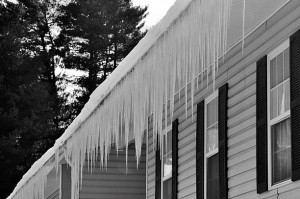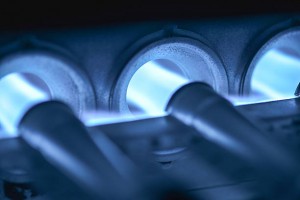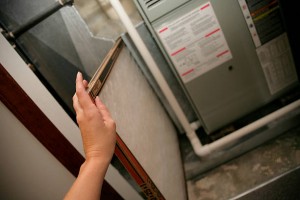Prevent Flooding: Maintain Gutters For Rain, Sleet, and Snow
September 20, 2023 | Posted in Uncategorized | By Mike Doetsch
It’s that time of year again. Winter has descended on the Chicago area bringing snow, sleet, and rain. While it seems that the icy blast will never leave us, tomorrow is the Winter Solstice, bringing longer, sunnier days. Before we know it Spring will be upon us, and any melting ice and snow will begin putting roof and gutter systems to the test.

Long heavy icicles posing an ice damage risk to the burdened eaves of a building after a severe winter storm.
One of the most important issues at this time of year, with storms regularly moving into the area, is to ensure that gutters and downspouts are functioning properly. Gutters are the front line of defense against water damage. They are extremely important for keeping a basement, crawl space, or lower level of a home dry, as failure to divert roof runoff may result in moisture in one of these areas. As soon as it is safe to do so, make sure that dirt and debris are removed from gutters so that melting snow and rainwater can flow freely. Even homes with gutter guards are not maintenance-free; many of these guards don’t work dependably and still need to be removed and cleaned to remove the debris that builds up behind the guard. Gutters that are damaged or sagging are equally problematic, since water will quickly follow the easiest route in its path and spill over an uneven edge. Overall, blocked or sagging gutters are worse than no gutters at all, as large amounts of water will build up and drain over one area onto the ground, rather than draining evenly over the length of a roof edge.
Debris-free gutters often do their job just fine, but if you find that water still drains over roof edges during heavy rains, consider installing commercial grade downspouts. These downspouts are larger in diameter and can handle almost twice as much water as traditional downspouts, therefore allowing heavy rains to quickly drain from the roof. More importantly, consider redesigning where your gutter downspouts are emptying water runoff. Gutters may be operating perfectly, but if the downspout is directing runoff into an area adjacent to your home, the water can easily accumulate against your foundation and find its way into the house. Fortunately this is an easy fix. Downspout extensions can be purchased at any home improvement center, and are easily installed. They should divert water a minimum of five to seven feet away from the foundation. If you find that they are unsightly, or impeding a walkway, you can opt to install an underground extension made of corrugated plastic, with a pop-up emitter attached at its end. This option allows you to direct the water away from your home to a destination of your choosing, whether it be a rain garden, a nearby drain, or the street.
If your gutter system is in good shape, then you are already set to go. If you do need to make improvements, don’t despair. A little bit of maintenance goes a long way in this case, and will allow for peace of mind when the first Spring rainstorm rolls into town.
Heat Your Home: Keep Your Furnace Working in Cold Winter Weather
September 1, 2023 | Posted in Uncategorized | By Mike Doetsch
 The onset of subzero temperatures brings us an influx of phone calls regarding problems with furnaces. As temperatures drop, we begin to demand increasingly more from our furnaces, but unfortunately many aren’t up to the challenge. Since we still have several months of cold weather ahead, this is still a good time to make sure that your heating system is in good working condition and prepared for the workload ahead. (Much of the following information can be addressed by a licensed HVAC technician; however, if you wish to have more than just your heating system evaluated, our Maintenance Check-up is an excellent idea).
The onset of subzero temperatures brings us an influx of phone calls regarding problems with furnaces. As temperatures drop, we begin to demand increasingly more from our furnaces, but unfortunately many aren’t up to the challenge. Since we still have several months of cold weather ahead, this is still a good time to make sure that your heating system is in good working condition and prepared for the workload ahead. (Much of the following information can be addressed by a licensed HVAC technician; however, if you wish to have more than just your heating system evaluated, our Maintenance Check-up is an excellent idea).
For most of us, regular care of a furnace isn’t a top priority – until it stops working. The first step in ensuring that that doesn’t happen is to find out when the unit was last serviced. Was it done recently? If not, the blower and inducing motors may need servicing. These components can become dirty, work themselves loose, or the bearings can deteriorate. Listen to the furnace while it is running; you can often detect odd noises that might indicate whether one of these situations is developing. Fixing a problem in its early stages can save your furnace, not to mention your wallet.
Another key component of your furnace is the filter, which removes excess particles from the air as it enters the unit. It is generally recommended to change your filter once a month, especially in summer and winter when the blower is working excessively. There are different types of filters on the market, including high-allergen filters (often listed as MERV 9 or above); however, we do not recommend the allergen filters because they are so thick that they can place excess strain on the furnace. Instead, we recommend the more inexpensive filters with a lower MERV rating, replaced a bit more frequently.
With freezing temperatures comes dry air. Our humidifiers are therefore working on overdrive as well. Humidifier pads can develop calcium build-up from water sources, which blocks the flow of water and diverts it to areas it shouldn’t be going. A common example is when humidifier water is diverted into the furnace itself, causing rust, damage, and eventual furnace failure. If you haven’t changed the pad in a while, inspect the area around the furnace. Look for water dripping under the humidifier or onto the furnace; these are signs that the unit is blocked and water is being misdirected. A general guideline to follow is to change your humidifier pad once each year, so if you haven’t changed it yet, now is a good time. It is easy to do, but you can have an HVAC technician do it, especially if you have one coming out for general servicing already.
Changing your own furnace filter and humidifier pad is relatively easy, and you can find both at most Big Box and hardware stores. Look for the name and model number on the side of your furnace unit, so you can purchase the appropriate size filter and pad. If you can’t find this information, you can pull the cover off of the humidifier and measure the pad, or simply take a few pictures that you can show to a salesperson at the store. The furnace filter location depends on the model, and can be a bit more difficult to find. It may be located on the side, bottom, or top of the unit, either easily accessible on the outside, or inside the unit where it is difficult to access. However, they should generally be located in the area where the return air duct connects with the main furnace unit. A professional technician can show you where your particular components are located. But, if we have performed an inspection on your home in the past, you can luckily call us for help!
Again, an HVAC technician can do all of these things for you, and this regular check-up should be done on an annual basis. An added benefit to hiring a professional is that, if you have a company come out to service the system every year, when a problem does come up (like your furnace shutting down on a below-zero night!) you’ll likely be near the top of their priority list versus a new client calling for the first time.
Lastly, if you have other concerns about your home in addition to your heating system, our Maintenance Check-up is an excellent service to provide you with peace of mind. The Check-up is identical to a pre-sale home inspection, providing you with an objective and utterly thorough analysis of all of your home’s systems – areas such as the roof, plumbing, electrical system, foundation, and everything in-between, including the furnace.
To read more about our Maintenance Check-up, click here.




